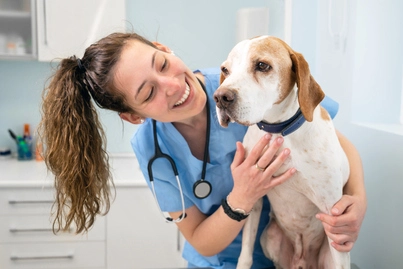Dogs don’t wear shoes every time they step outside – surely, there are consequences for taking on the world barefooted?
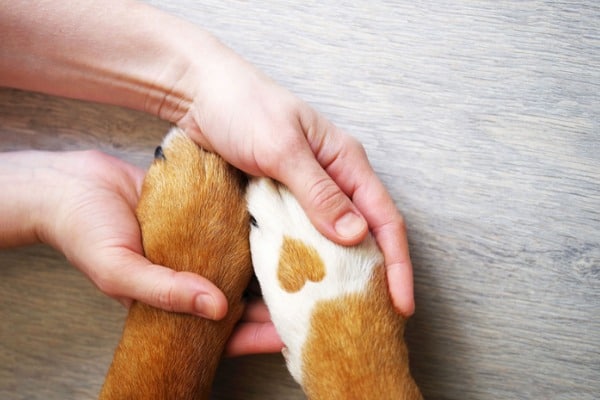
As you probably already know:
Dog paws are surprisingly resilient against nature and the elements, as they were designed to be.
So if you realize your dog’s paws are peeling, you may wonder where you went wrong in protecting those precious paws.
Spoiler:
Sometimes, you do everything you’re supposed to, and your dog’s paws still look less than normal.
The causes of peeling, cracked, or damaged paw pads range from weather and nervous licking habits to common dog health issues like allergies.
There’s always a fix for beat-up paw pads, and it doesn’t have to involve boots – which is good news for the pups who can’t stand to wear them.
Connect with a verified veterinarian in minutes. No waiting for appointments or office hours. No high fees. Your pet's health made convenient and worry-free.
Reason 1 For Peeling Pads: Winter Weather
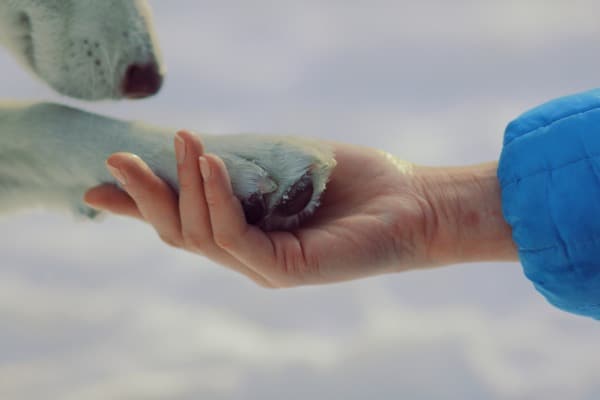
If you live in a region that experiences a true winter season, then you know how harsh it can be on your skin.
Running the heating constantly, high altitudes, and windy weather can all add to the issue.
You know what happens when your skin is exposed to dry, winter air: chapped lips, cracked skin, and overall unpleasantness when you forget your hand or lip balm.
Your dog isn’t immune to nasty winter climates, either.
They have less of a need for lip balm and more of a need for paw balm.
Those tough feet can only take so much walking on snow, ice, and even the salt we lay down on the walkway.
Not so fun fact:
Peeling can be due to minor chemical burns from walking on salt.
Peeling attributed to these things is usually not deep or bloody – you can think of it the way your lips peel when they’ve been chapped. Only the top layer of the skin is sloughing off.
If the peeling looks more like a cut, that’s a separate issue that we’ll address soon.
For now:
We’ll review some of the things you can do to shield your dog’s feet during winter.
Paw Balm
There’s no shortage of paw balm available in pet stores and online. You can even DIY it at home.
It’s not just for sled dogs anymore – your dog could benefit from paw balms and waxes if they spend a lot of time outdoors in winter.
Paw balm can help heal minor issues such as peeling or flaking and paw cracks. It also provides a barrier against snow, ice, and salt.
This is a fantastic option for dogs who don’t cooperate with booties. They won’t notice the paw balm, but it still provides a durable layer of protection between their paws and the elements.
Booties
If your dog does cooperate when it comes to wearing shoes, booties offer the ultimate paw protection.
Some booties are designed for the heat, while others are made for winter, so be sure you buy a set appropriate for winter.
If your dog already has some paw pad peeling, it’s often helpful to use paw balm and booties together.
The balm will moisturize your dog’s feet and help heal existing cracks, and the booties will prevent further problems.
Wipe Your Paws!
Some of you might already have your dog trained to wipe their feet on a mat before coming inside.
If not, don’t worry.
Wiping their feet with a towel after they’ve been outside takes all of sixty seconds.
Doing so will help remove any salt or chemicals on their feet, which you probably don’t want on your floors, either.
Unscented baby wipes or grooming wipes designed for dogs are also good to keep by the door.
Washing with mild soap and water a few times a week is helpful – take care to rinse the soap thoroughly to avoid further drying of the paws.
Wiping their feet also give you a chance to inspect the areas between their toes and check their paw pads for any new cuts or cracks.
Another common winter issue is balled-up snow and ice between the toes.
During the paw-cleaning routine, help your dog out by removing any icy debris stuck in their hair between the toes.
Reason 2 For Peeling Pads: Heat
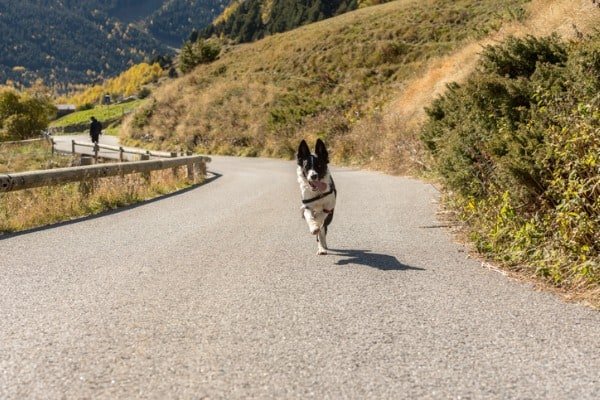
Warm weather can be as detrimental to your pup’s feet as the cold.
If you notice your dog’s paw pad peeling off, they could have experienced a blister from walking on hot surfaces.
Luckily:
You can take simple measures to prevent this from happening to your dog.
The Ten-Second Rule
Here’s an easy way to know if the road, sidewalk, or trail is too hot for your dog to walk barefoot: touch the back of your hand or your own foot to the surface for ten seconds.
If you have to tap out before you reach ten, then it’s too hot for your fur baby, too.
Booties for Summer
Like winter booties, summer shoes are easily obtained to protect your dog’s feet from hot pavement.
Be sure to use summer-appropriate ones, as winter ones might not always be enough to protect against heat.
Reason 3 For Peeling Pads: Lick Granulomas
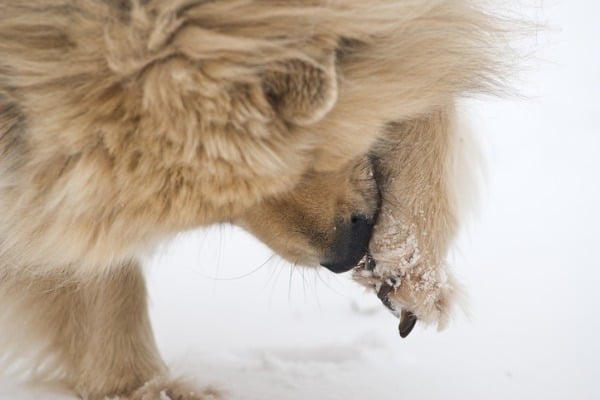
Dogs who excessively lick their paw or leg usually do so on top of the paw or forearm.
Sometimes, they can have a lick granuloma on their paw or between their toes.
Lick granulomas can be a nervous habit or indicate chronic pain due to bone or joint issues.
It’s crucial to have the underlying cause diagnosed by a vet.
Check out between your dog’s toes for redness. This is another good clue.
In the meantime:
A dog who obsessively licks their paws can damage them and cause peeling, cracking, or even open sores.
The cone of shame is, unfortunately, necessary in this case.
If the lick granuloma is due to anxiety or other psychological issues, then you’ll need to evaluate your dog’s routine and environment.
Separation anxiety, irritating noises, or sudden changes in lifestyle are common reasons dogs start licking their legs or paws out of anxiety.
Reason 4 For Peeling Pads: Daily Wear and Tear
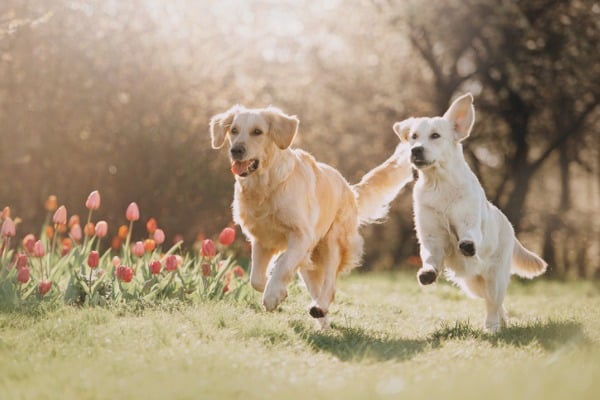
Dogs run, walk, and play on a variety of unforgiving surfaces.
Asphalt, concrete, and even rocky soil can be enough to cause scrapes on the upper dermal layer of your dog’s paws.
Particularly active dogs are more prone to having scraped-up paws. Puppies and elderly dogs also have softer, more sensitive paw pads that might scrape and crack easily.
Booties – Again
Are you sensing a recurring theme in prevention here?
Booties might be a menace to your dog, but sometimes it’s the only way to ensure their feet get proper protection.
Outdoorsy pet parents should consider putting booties on their dog any time the pair of you are enjoying rough terrain.
Long, frequent walks or runs on hard surfaces can also require an extra barrier to shield paw pads.
If you and your dog are active in outdoor activities, or you’re planning on taking your new puppy on many adventures, it’s a good idea to acclimate them to booties.
They might not need them all the time, but it’s helpful if they accept them whenever they’re needed.
Reason 5 For Peeling Paw Pads: Allergies

Grass, pollen, lawn treatments, household cleaners, and even dog food are common sources of allergens.
Some dogs are more sensitive than others to these allergens, and allergies can manifest themselves in peeling or flaky paws.
Avoiding Irritants
It can be difficult to help dogs who are extra sensitive to outdoor allergens.
After all, we can’t control nature.
What you can do is avoid places that have been treated with pesticides, fertilizer, or insecticides.
If you have an allergic dog, you’ll need to scale back these things in your own yard.
What if you live in an apartment complex or can’t know for sure if your dog’s stomping grounds are free of chemicals?
You guessed it – strap on those booties.
You can also wash or wipe your dog’s paws after walks to negate the effects of lawn chemicals.
Inside your home, things are a little easier to control.
Avoid harsh household cleaners and stick to natural ones. Heavy-duty carpet shampoo, scented carpet sprays or powders, and even air fresheners can trigger your dog’s allergies.
When to Call the Vet
Dog paw pads cracked, and peeling isn’t anything to panic about.
However, if it appears your dog’s paw pad is coming off, you do need to take them to the vet.
A blister or open wound on your dog’s paw can be very painful for them and also become infected very easily.
A trusted vet should evaluate the wound and might order a round of antibiotics for your dog.
Ice can be as dangerous as too hot of a surface for your dog. Even hard, packed snow can cause painful cuts that require first-aid and vet treatment.
Cuts due to sharp rocks or other sharp objects are another reason to visit the vet’s office. When a thick layer of paw pad seems to be coming off, your dog needs medical attention.
If your dog’s peeling paw pads have no apparent cause or don’t seem to improve with home treatments and prevention, your vet can also evaluate your dog for allergies or other possible culprits.
Connect with a verified veterinarian in minutes. No waiting for appointments or office hours. No high fees. Your pet's health made convenient and worry-free.
Don’t Peel!
Flaking and peeling paw pads might tempt you and your dog to pull at dead skin.
You definitely don’t want to encourage your dog to do this and should avoid doing it yourself.
Think again about chapped lips.
We’ve all been there at least once: pulling at dead skin, which is still attached and making a sore, bloody mess of things.
The same logic can be applied to your dog’s paws. Pulling off dead skin can pull at live tissue and worsen the situation.
Instead:
Keep applying the paw balm and let the dead skin come off on its own.
Excess licking and chewing can keep your dog in a cycle of raw, flaky paws.
Here’s where the booties can come in handy yet again. If your dog is chewing and licking at cracked or peeling paws, the boots can allow the paw pads the chance to heal on their own.
Healing the Soles
Prevention is important to avoid paw issues.
Summer, winter, allergens, and hard terrains can all do more than cause peeling paw pads – they can lead to nasty injuries.
However:
Don’t worry too much if your dog’s paw pads are cracked and peeling. Often, everyday routines are enough to cause a little stress on those otherwise hearty feet.
The causes depend on environmental factors and everyday habits, all of which can be counteracted with paw balms, boots, paw washing, and other easy preventive measures.
In the event of a cut or peeling that has no apparent cause, a vet should have a look at those feet.
If this is an issue you and your dog battle regularly, then they might need to accept the fact that booties and paw balm are going to be a part of daily life.
Fear not – they’ll forgive you for making them wear shoes.

